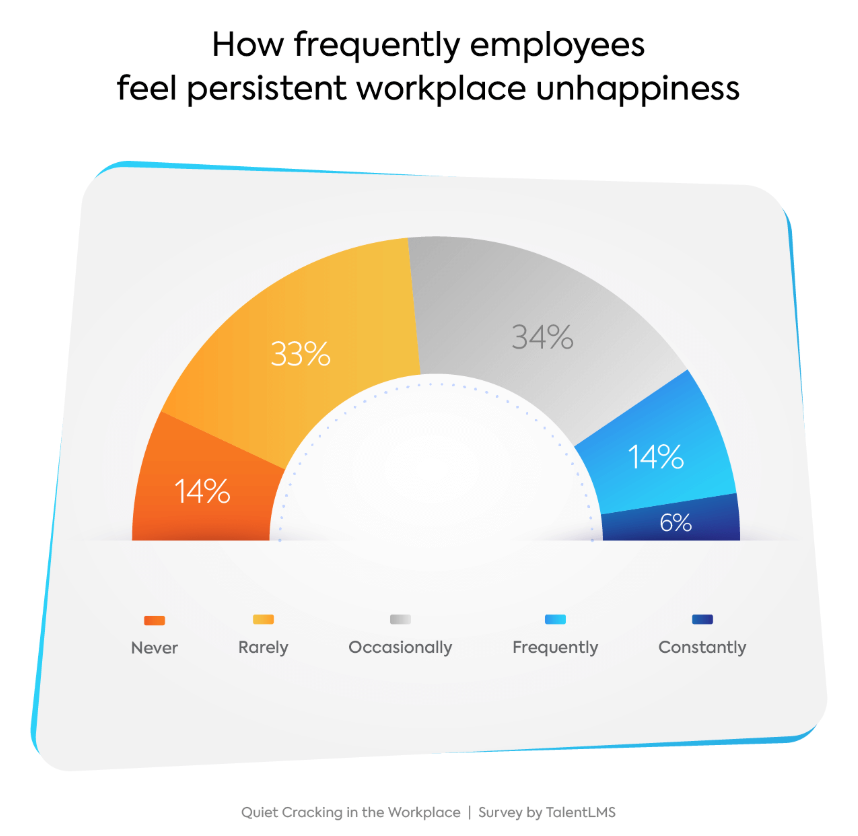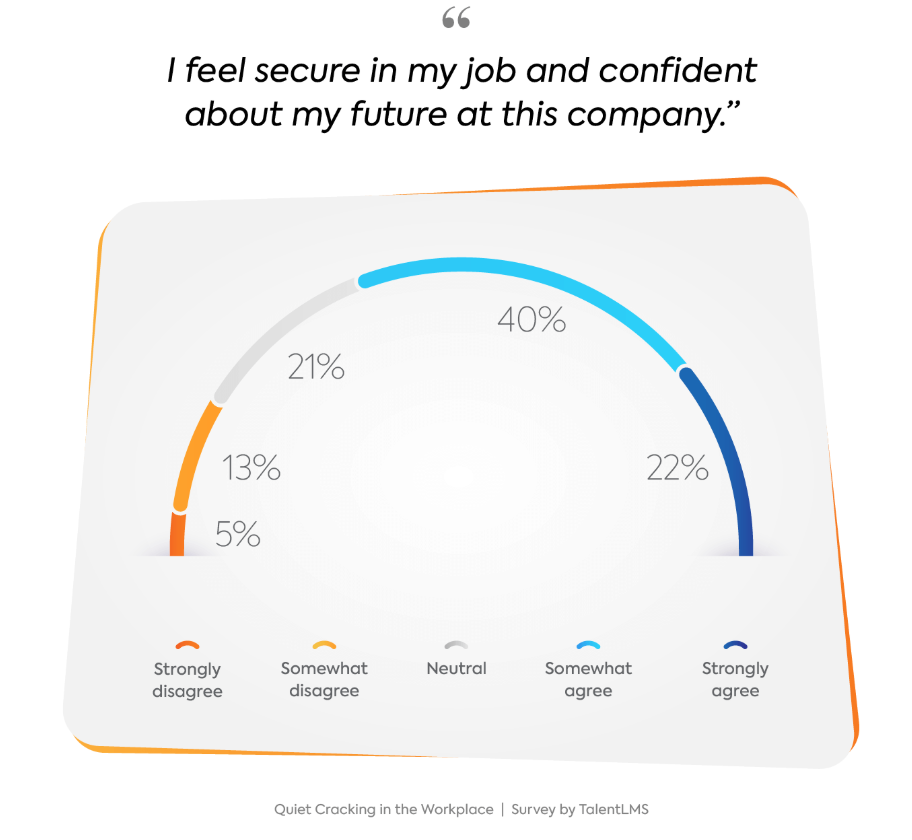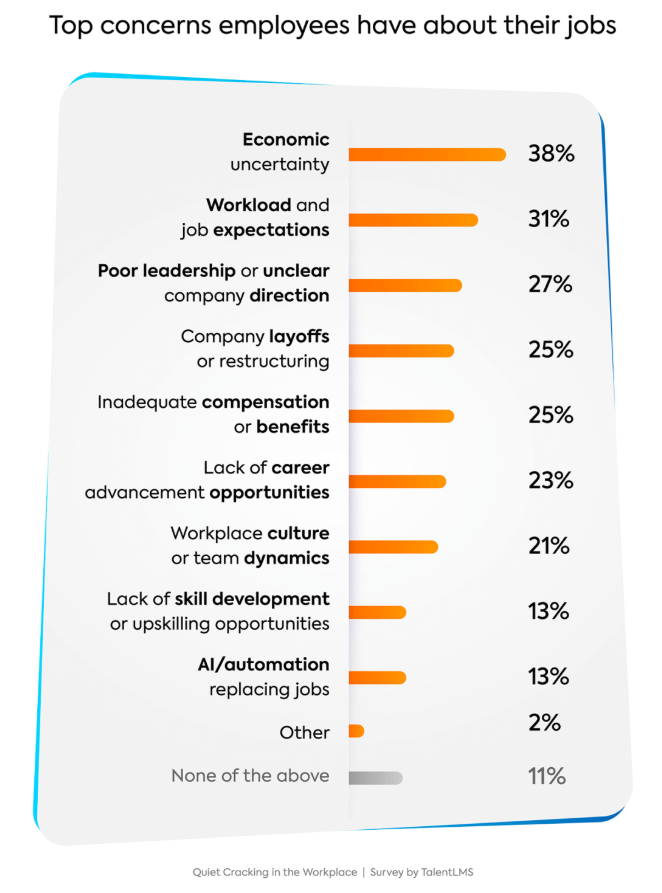‘When people feel stuck, unheard, or unsure about their future, that's when disengagement creeps in’

More employees are becoming hesitant to take on extra responsibilities, share ideas with their teams, or attend company events.
Labelled "quiet cracking," this trend is being experienced by 54 per cent of U.S. workers, with six per cent report feeling this way frequently or constantly — though 47 per cent of employees say they rarely or never experience these feelings.
Quiet cracking is defined as a persistent sense of workplace dissatisfaction that leads to disengagement, reduced performance, and a heightened desire to quit. Because it often goes unnoticed, TalentLMS says that it can be particularly insidious for business leaders.
"Quiet cracking may not be obvious at first, but over time it can wear down team energy, connection, and trust," says Nikhil Arora, CEO of Epignosis, the parent company of TalentLMS.

Millennials, the largest cohort in today’s workforce, are also the least satisfied, according to a previous report.
What causes quiet cracking?
Quiet cracking is the gradual erosion of workplace satisfaction, driven by multiple employment-related factors, says TalentLMS.
Job security plays a key role. While 82 per cent of employees feel secure in their current position, only 62 per cent feel confident about their long-term future with the company. Nearly one in six (18 per cent) are unsure if they have a future with their current employer, found the survey of 1,000 U.S. workers.

“Companies with retention initiatives or internal surveys that show their people are overall satisfied with their jobs might be at risk of having a false sense of security about their employees’ mindset,” says TalentLMS.
“The disconnect we found in this data between overall job security and how employees feel about their future with their company indicates something that should alarm leaders—that people are not worried about losing their jobs but they don’t really feel like the employer-employee relationship is going to last.”
Workers also have a variety of pressing concerns, including:

There’s also an ongoing managerial disconnect. Overall, 62 per cent of employees say their manager listens to their concerns, compared with 20 per cent who feel their manager does not.
For employees who say they are experiencing quiet cracking, 47 per cent say managers do not listen to their concerns, says TalentLMS.
Also, many workers express growing dissatisfaction with their employer due to lack of upskilling opportunities.
While 56 per cent of employees say they have received training from their employer in the past year, 42 per cent claim the contrary. And employees who frequently or constantly experience quiet cracking are 68 per cent less likely to feel valued and recognized at work compared to their peers who do not have the same experience.
There is, however, a wide gap in the numbers between those who experience quiet cracking and those who don’t, according to TalentLMS.
|
Percentage of workers |
Percentage of workers |
|
|---|---|---|
|
Have received training in past 12 months |
44 per cent |
62 per cent |
|
Feel valued and recognized |
26 per cent |
80 per cent |
Keeping employees connected and productive in remote and hybrid work environments is a growing challenge for employers, according to a previous report by TeamViewer.
How to combat quiet cracking
TalentLMS suggest that employers can fight quiet cracking by doing the following:
- Survey employees: HR and leadership should know if their employees are suffering from persistent feelings of unhappiness.
- Empower managers with empathy: Listening, regular check-ins, and recognition can dramatically improve employee sentiment.
- Double down on learning and development: Employees who receive regular training are more likely to feel confident, engaged and valued.
- Recognize contributions frequently: Low-cost recognition programs can deliver a high impact on employee morale.
- Clarify expectations and manage workloads: When people know what's expected and workloads are balanced, disengagement drops.
“The solution isn't complicated. When people feel stuck, unheard, or unsure about their future, that's when disengagement creeps in,” says Arora.
“Giving employees space to grow — through learning, skilling, and real conversations — is one of the most powerful ways to turn things around. It not only shows people they matter, but helps them rediscover a sense of purpose and forward momentum, something we all seek at work and in life."
Also, here are some best practices for improving employee engagement, according to Randstad:
- Develop strong leaders by doing the following:
- Put the right workers in management positions.
- Identify which candidates have the right leadership skills.
- Offer leadership onboarding and training.
- Provide tips for how to handle employee recognition.
- Streamline the workforce management process.
- Improve communication and transparency between employer and employees.
- Set core company values.
- Build a culture of recognition.
- Invest in employee training and development.
- Encourage frequent feedback.
- Maintain a safe and efficient work environment.
- Focus on employee wellness.




